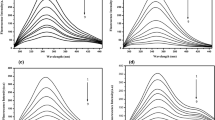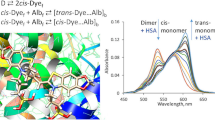Abstract
We have studied the interaction between polycyclic aromatic hydrocarbons (pyrene and anthracene) with human serum albumin (HSA) and human blood plasma. We have shown that the increase in the fluorescence intensity and the decrease in the polarity index of pyrene on going from an aqueous solution to a pH 7.4 buffer solution of HSA suggests that polycyclic aromatic hydrocarbons are localized in the hydrophobic microphase of the proteins. The increase in the fluorescence intensity for anthracene and pyrene, and also the decrease in the polarity index of pyrene on going from HSA to blood plasma is connected with the fact that polycyclic aromatic hydrocarbons can bind both to plasma proteins and to plasma lipids. When sodium dodecyl sulfate (SDS) is added to the blood plasma in a concentration greater than the critical micelle concentration, we observe an increase in the fluorescence intensity and the polarity index of pyrene. We hypothesize that this is connected with localization of pyrene near the interface between the hydrophobic and hydrophilic phases of the protein-SDS system. We have established that SDS leads to a change in the structure of blood plasma proteins and promotes escape of polycyclic aromatic hydrocarbons from the protein globules.
Similar content being viewed by others
References
G. E. Dobretsov, Fluorescent Probes in Study of Cells, Membranes, and Lipoproteins [in Russian], Nauk. Dumka, Kiev (1988).
A. P. Demchenko, Luminescence and Dynamics of Protein Structure [in Russian], Nauk. Dumka, Kiev (1988).
K. Kalyanasundaram and J. K. Thomas, J. Am. Chem. Soc., 99, 2039–2045 (1977).
A. I. Deev, Yu. G. Osis, V. E. Formazyuk, et al., Biofizika, 28, 629–631 (1983).
V. Glushko, M. S. R. Thaler, and C. D. Karp, Arch. Biochem. Biophys., 210, 33–42 (1981).
N. L. Bekshin and I. S. Litvinov, Mol. Biologiya, 15, 1188–1193 (1981).
D. C. Dong and M. A. Winnik, Photochem. Photobiol. A, 35, 17–21 (1982).
G. V. Mel’nikov, T. I. Gubina, and O. A. Dyachuk, Zh. Fiz. Khim., 80, 1–5 (2006).
A. N. Baranov, I. M. Vlasova, and A. M. Saletskii, Zh. Prikl. Spektr., 71, 204–207 (2004).
V. M. Mazhul’, E. M. Zaitsev, and D. G. Shcherbin, Biofizika, 45, 965–989 (2000).
M. Almgren, F. Grieser, and J. K. Thomas, J. Am. Chem. Soc., 101, 2021–2026 (1979).
G. E. Dobretsov, N. K. Kurek, V. N. Makhov, et al., “Forster energy transfer between fluorescent probes in models of biological membranes,” Preprint FIAN SSSR, Moscow (1987), No. 11.
Author information
Authors and Affiliations
Corresponding author
Additional information
__________
Translated from Zhurnal Prikladnoi Spektroskopii, Vol. 75, No. 3, pp. 379–382, May–June, 2008.
Rights and permissions
About this article
Cite this article
Saletskii, A.M., Mel’nikov, A.G., Pravdin, A.B. et al. Complexation of pyrene and anthracene with human blood plasma. J Appl Spectrosc 75, 402–406 (2008). https://doi.org/10.1007/s10812-008-9060-3
Received:
Published:
Issue Date:
DOI: https://doi.org/10.1007/s10812-008-9060-3




